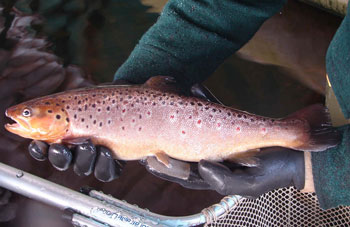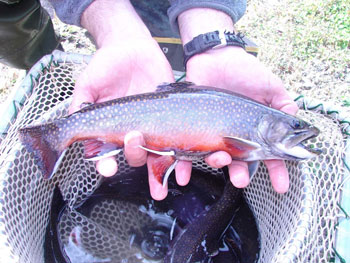Tidewater Brown Trout
by Tom Seymour

Seeforellen strain brown trout. This strain is the wildest in the country. It originated from wild European stock and was brought here in 1980. The fish in this photo is being saved as a broodstock fish at the MDIF&W Fish Rearing Station in Palermo. Photo by Tim Seymour
Maine holds national fame as the last stronghold of native brook trout. But wild, self-sustaining brook trout cannot live in some waters. Many picturesque streams and rivers are too warm and shallow for wild brook trout. In that case, The Maine Department of Inland Fisheries and Wildlife (DIF&W) provides angling opportunities by virtue of its hatchery system.
Maine’s fish hatcheries and rearing stations work together to maintain trout populations where they would not otherwise exist. It works this way:
Adult, or broodstock fish are stripped of eggs and milt and these are combined and then hatched out in a hatchery setting. When the tiny fish become large enough to ship, they are then transported to a rearing station, there to grow to a size where they may be released into the wild in order to provide either immediate fishing opportunities or to grow to even larger sizes.
Hatchery-raised salmonids have grown in length, weight and overall quality over the years. Natural causes influence growing conditions in rearing stations in that early-arriving springs and mild winters cause fish to feed more actively and thus grow larger, faster. And DIF&W fisheries biologists use the latest technology and methods in order to achieve the best possible end results.
Also, the food that hatchery-reared fish eat has undergone a vast improvement over the years. Once, raw liver was ground and fed to trout. This was cheap, but certainly not ideal. Besides that, liver-fed trout tasted like, well, liver. Today, Maine’s hatchery fish are fed a high-protein diet of pellets made, at least in part, of seafood by-products. This diet prompts extra-fast growth and also, influences the texture, taste and color of the flesh. Maine’s stocked trout are quality fish, high-grade in every detail.
Here are some figures from the year 2010. Remember, these are for salmonids and they include brook, rainbow and brown trout, splake (a hybrid of brook/lake trout) landlocked salmon and to a very small degree, lake whitefish. Trout, certainly, make up the bulk of fish stocked, however. Given that, the total number of salmonids released by DIF&W in 2010 was 1,454, 279 fish. These totaled an incredible 377,863 pounds.
So where do these fish go? No simple answer exists for that, since hatchery fish are planted throughout the state at different times of the year for a variety of different reasons.
In years past, the only way to learn where and when fish were stocked was to refer to the previous year’s stocking list and proceed on the supposition that the same number of fish would be released in the same water at somewhere around the same time. That has all changed.
Now, DIF&W posts online reports of daily activity. Anyone with Internet access can go online to www.mefishwildlife.com, click on Fishing and then proceed to reports. From there, it’s easy to navigate and to find up-to-date information on specific waters.
Typically, fish-filled tanker trucks leave rearing stations sometime in April. In 2010, stocking began during the first week of April. This year, lingering, winter-like conditions will push that schedule back somewhat. But when the stocking begins it begins in earnest. Once embarked upon, the process does not stop until all fish scheduled for stocking are released. Each day, trucks leave rearing stations throughout the state, to discharge fish into various waters throughout their different districts.
Coastal Waters
While many of the fish released by DIF&W go to inland waters throughout the state, a number are stocked in rivers and streams. Some of these flowing waters are near the coast. Other points of stocking are on streams that flow, unimpeded, to the sea.
As pointed out in the February, 2009 issue of Fisherman’s Voice, a certain segment of the native brook trout population become anadromous and spend part of the year in an estuarine environment. The amount of time spent in the saltwater depends upon a number of factors and differs from stream to stream.
But Maine also has a different kind of anadromous trout. These are brown trout, stocked where they have the opportunity to drop down to the sea if they so desire. This is known to DIF&W as the “tidewater fishery” and fish stocked for that purpose are all brown trout. However, DIF&W maintains three different strains of brown trout, several of which have great possibilities regarding becoming sea-run.
Southern Maine (Region A) and Mid-Coast Maine (Region B) both host tidewater trout programs. Before getting into details, let’s look at the program’s history.

Fall yearling brown trout. So where do these fish go? No simple answer exists for that, since hatchery fish are planted throughout the state at different times of the year for a variety of different reasons. Photo by Tim Seymour
Tidewater Browns
The sea-run brown trout project is nothing new for DIF&W. According to a DIF&W bulletin B-389, written by fishery biologist Urban D. Pierce Jr. in 1978, rivers and streams up and down the Maine coast have long supported limited populations of sea-run brown trout. These were, according to Pierce, stocked fish that made their way to sea on their own, simply by chance. Pierce lists the inception of the officially sanctioned tidewater brown trout program as happening in the early 1970s, when planners put into effect an experimental program on three coastal streams in southern Maine.
Much has happened in the intervening years. The program achieved a degree of long-lasting success in that for many years, people who were aware of the possibilities often caught 2- to 3-pound brown trout, with the occasional 4- to 8-pound individual. Most of this activity was not advertised or widely published. In fact, those weights given above are from anecdotal evidence offered by coastal Maine anglers who have long sought sea-run brown trout. Currently, fish of around 2 pounds make up the preponderance of the fishery.
Today, DIF&W stocks three tidal rivers with brown trout in Southern Maine’s Region A. These include The Ogunquit River in Wells, the Mousam River in Kennebunk and the Salmon Falls River in South Berwick. Tidal sections of these offer easy access, a real plus given that best fishing for sea-run brown trout occurs from November through January.
Region B in Mid-Coast Maine has a limited tidewater fishery on the St. George River in Warren and also, the Medomak River in Waldoboro. Both rivers are stocked with brown trout and brook trout several times each year.
New Strains
To the casual observer, it may seem that brown trout are, simply, brown trout. But as with any cultured species, various strains abound. Consider first, that unlike brook trout or even rainbow trout, brown trout are not native to this continent. Rather, they were imported from Europe in the late 19th century.
Maine has, since 1968, propagated New Gloucester State Fish Hatchery brown trout, Salmo trutta. These were established from an unknown number of wild parents. Since 1974, the New Gloucester strain was spawned every three years with wild fish from several different Maine waters. But genetic shortcomings have prompted DIF&W biologists to look for a replacement to the New Gloucester strain.
To that end, two newcomers to Maine swim in DIF&W fish rearing station waters. These are Seeforellen and Cape Cod/Sandwich strains. Seeforellen have performed well in highly competitive situations and have yielded high angler catch rates. They are thought to make the transition to a saltwater environment with ease, making them good candidates for a sea-run, brown trout program.
The Sandwich strain springs from feral, tidewater brown trout. These have desirable genetics and also, are thought suitable for the sea-run, or tidewater program.
Both strains were stocked in Maine waters in 2010. Inadequate time has passed for any quantitative evaluation of how these fish have or will perform. Certainly, both show great promise.

Since 1974, the New Gloucester strain was spawned every three years with wild fish from several different Maine waters. But genetic shortcomings have prompted DIF&W biologists to look for a replacement to the New Gloucester strain. Photo by Tim Seymour
Tidewater Specifics
Francis Brautigan, regional fisheries biologist for DIF&W Region A, explained some of the successes and disappointments of the tidewater program.
“Some years are better than others,” Brautigan said. “This may be because some fish are better able to make the transition to living in tidal water. It’s an area that needs more research.”
Brautigan explained that besides the ability or inability to acclimate to a new environment, a number of natural factors bear upon how stocked trout fare in tidal water. Predation takes a toll, certainly. Creatures that prey upon newly-stocked brown trout include seals, cormorants, striped bass and when they venture into Maine waters, bluefish.
Also, reports of anglers taking carryover fish may be slightly skewed because DIF&W regularly releases “broodstock” fish, large adults that have passed their prime and are no longer useful for use in propagating more brown trout.
Still, and again this comes from anecdotal evidence rather than from laboratory testing of scale samples, people often do take huge brown trout, fish of 6 - 8 pounds and larger. hese trophy trout sometimes come to anglers fishing for striped bass from beaches, rather than from people fishing directly in streams or rivers.
The Future
With an ever-decreasing budget and at best, uncertain results, what’s the future of DIF&W’s tidewater program? Well, it is here to stay. As biologists become more familiar with the new strains of brown trout, they will better be able to place them out when and where they can have the optimum chance of success.
Catching a silvery-bright brown trout fresh from the sea rates as every trout fisherman’s dream. The tidewater program offers just that opportunity.
